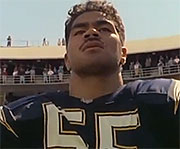
THURSDAY, Jan. 10 (HealthDay News) — When former National Football League star linebacker Junior Seau killed himself last year, he had a catastrophic brain disorder probably brought on by repeated hits to the head, the U.S. National Institutes of Health has concluded.
The NIH scientists who studied Seau’s brain determined that he had chronic traumatic encephalopathy (CTE). They told the Associated Press on Thursday that the cellular changes they saw were similar to those found in autopsies of people “with exposure to repetitive head injuries.”
The disorder — characterized by impulsivity, depression and erratic behavior — is only diagnosed after death.
Seau, 43, who played pro football for 20 seasons before his retirement in 2009, shot himself in the chest last May. His family donated his brain for research.
Some experts suspect — but can’t prove — that CTE led to Seau’s suicide.
“Chronic traumatic encephalopathy is the thing we have typically seen in a lot of the athletes,” said Dr. Howard Derman, director at the Methodist Concussion Center in Houston.
“Rather than say ‘this caused this,’ I think the observation is that there have been multiple [pro football] players now who have committed suicide: Dave Duerson, Andre Waters, John Grimsley — although Grimsley was just reported as a gun accident,” Derman said.
Some argue that these players became depressed once they were out of the limelight or because of marital or financial difficulties, but Derman thinks the evidence goes beyond that.
“Yes, all that may be going on … but it still remains that the majority of these players who have committed suicide do have changes of chronic traumatic encephalopathy. We feel that that is also playing a role in their mental state.”
But, Derman cautioned, “I can’t say that chronic traumatic encephalopathy causes players to commit suicide.”
Chronic traumatic encephalopathy was first noticed in boxers who suffered blows to the head over many years. In recent years, concerns about CTE have led high school and college programs to restrict hits to the head, and the National Football League prohibits helmet-to-helmet hits.
About 4,000 former NFL players filed a class-action lawsuit last year claiming the league failed to protect players from traumatic brain injuries or warn them about the dangers of concussions.
The NFL has said that it never intentionally hid the dangers of concussion from players, and that it is now doing everything it can to protect players against concussions. The league has given a $30 million research grant to the National Institutes of Health for that purpose.
“I was not surprised after learning a little about CTE that he had it,” Seau’s son, Tyler, 23, told the AP. “He did play so many years at that level. I was more just kind of angry [that] I didn’t do something more and have the awareness to help him more, and now it is too late.”
Seau’s son said the family was unaware of the side effects associated with head injuries. “We didn’t know his behavior was from head trauma,” he said.
Seau’s ex-wife, Gina Seau, told ABC News that although her ex-husband was never formally diagnosed with a concussion, he often complained of symptoms that are related to one. Those symptoms included mood swings, irrational behavior, forgetfulness, insomnia and depression.
Dr. Russell Lonser, who led the study on Seau’s brain, told the AP that the brain was independently evaluated in a “blind” fashion, meaning it was one of three unidentified brains. “We had the opportunity to get multiple experts involved in a way [that] they wouldn’t be able to directly identify his tissue even if they knew he was one of the individuals studied,” Lonser said.
Last month, Boston University School of Medicine researchers reported in the journal Brain that people with CTE experience four specific phases, beginning with memory disruption and thinking problems and ending with aggression.
The Boston researchers said the condition had been diagnosed in 34 former professional players and nine former college football players.
Seau, who was divorced, played with New England, San Diego and Miami during his NFL career.
More information
For more about chronic traumatic encephalopathy, see the American Academy of Neurology.

